Growing dill is simple and rewarding, and they don’t require much care. In this post, I’ll show you everything you need to know in order to have your best crop ever.
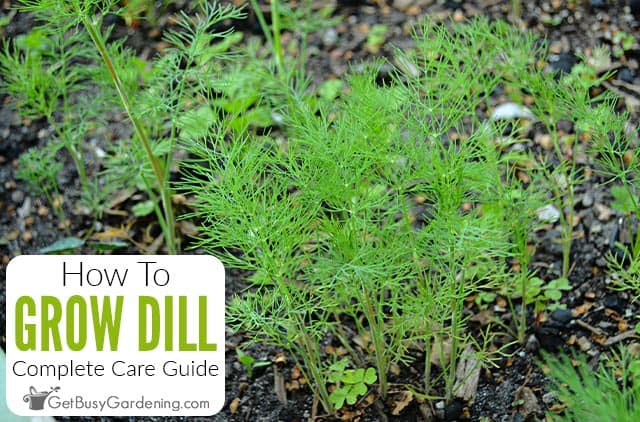
Dill is a beautiful and useful herb that’s easier to grow than many beginners may think.
Once you understand when to plant it and how to care for it, you can enjoy an abundance right from your home garden.
In this guide you’ll learn everything you need to get started growing dill. Discover its sun, soil, water, and fertilizer requirements, and much more.
Dill Plant Care Overview
| Scientific name: | Anethum graveolens |
| Classification: | Herb |
| Common names: | Dill |
| Hardiness: | Annual |
| Temperature: | 60-75°F |
| Flowers: | Yellow flowers in early summer |
| Light: | Full sun to partial shade |
| Water: | Allow soil to dry between waterings, do not overwater |
| Humidity: | Average |
| Fertilizer: | General purpose plant food in spring |
| Soil: | Fast-draining, fertile soil |
| Common pests: | Black swallowtail butterfly caterpillar (beneficial) |
Information About Dill Plants
Dill (Anethum graveolens) is a flowering herbaceous annual plant from the Umbellifer family, which also includes parsley, carrots, and celery.
It’s natively from Mediterranean regions, but is grown all over the world now. Both the leaves and the seeds are edible, and useful in cooking.
The tall fronds can grow up to 4’ and produce starbursts of yellow flowers in the summer that are attractive to pollinators.
Different Types Of Dill
There are many types of dill, and they all can be grown with the same kind of care.
What you choose should depend on your climate, space, and intention. Some are more fragrant and flavorful, while others grow compact, or are resistant to bolting.
You might try one of the popular varieties to start with such as Mammoth, Bouquet, Elephant, Fernleaf, or Eneldo.
Hardiness
Though dill is a short-lived annual plant, it grows well in a wide range of climates.
It’s fairly cold hardy, and can tolerate temperatures down to 25°F once established.
But it does not like it hot, and will bolt, or go to seed, as soon as the heat of summer kicks in.
How Does Dill Grow?
The edible dill leaves branch out into feathery fronds that form all along the center stem.
As the season goes on, the plant will get taller, and a small starburst of yellow flowers will form at the top of the stem.
If left on their own, the flowers will set seed, which can be used in cooking, to fill your spice rack, or saved and planted again next year.
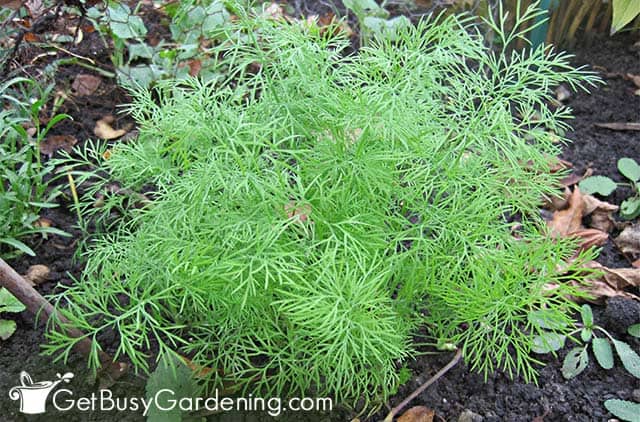
How To Grow Dill
Before we discuss how to care for it, we need to chat about where and when to get it started. Choosing the best place and time of year are both key to how well your dill will grow.
Where To Grow Dill
Finding a good place to grow dill is easier than you might think, it’s adaptable to several locations.
It can flourish in the garden, containers, or even indoors in the right conditions. Outdoors in the garden, give them an are with partial to full sun and well-draining soil.
For containers, choose a large one with drainage that can handle the full height and deep taproot. Dill plants don’t need a ton of space, so you can put several in one large container.
When To Plant Dill
Timing is everything when it comes to successfully growing a good dill crop. One reason many beginners find it difficult is because they’re planting it at the wrong time.
It prefers cold weather, and can’t handle the heat. So you need to plant it as soon as the soil is workable in early spring, or in later summer for a fall crop.
Ideally, the ground temperature should be between 60-70°F, which you can check with a soil thermometer.
It also does not transplant well, and doing so can trigger premature bolting. So always direct sow the seeds rather than starting them indoors.
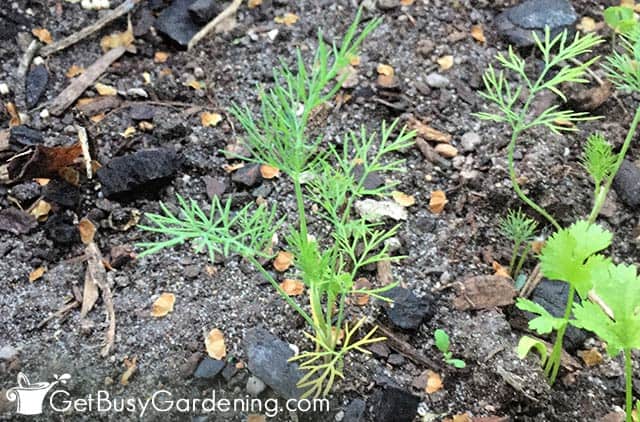
Dill Plant Care & Growing Instructions
Now that you have a good idea on where and when to grow dill, it’s time to learn all about how to care for it. Follow these tips to get yours to flourish.
Sunlight
Dill will grow best in full sun, with 6-8 hours of direct light per day. It also does very well in partial shade, but the plants won’t be as bushy.
If you live in a very warm region however, providing shade in the hottest part of the afternoon can prolong its life.
In that case, either give it a location where it gets only morning or evening sun, or use a shade cloth to shield it from the hot afternoon rays.
Water
Water your dill regularly and deeply to keep it healthy. It likes slightly moist soil, but doesn’t like having wet, soggy feet.
As young plants, keep the top layers of soil damp. When they’re established and the taproot has formed, it’s best to allow the top 2-3” to dry between deep, thorough drinks.
In hot weather you may find that it needs more frequent watering. Use a moisture gauge to help get it just right.
Temperature
Though it looks very delicate, dill is tolerant of a surprising range of temperatures. It’s cold hardy down to 25°F, and can handle temperatures up to 80°F.
For the best leaf growth, ranges between 60-75°F are ideal. When it gets much hotter than that, the plant will bolt.
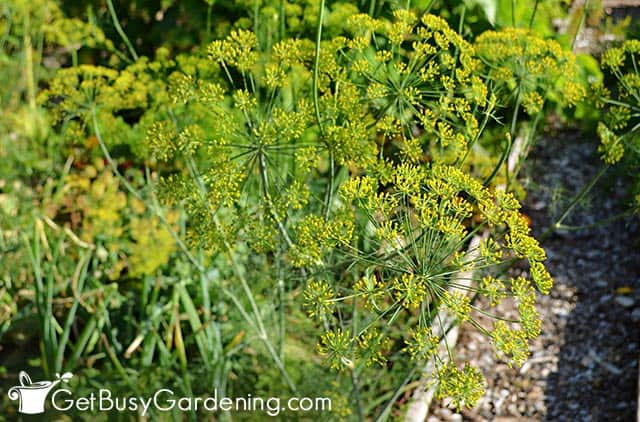
Fertilizer
If you begin with rich soil, you may not need to fertilize dill very much. However, the occasional feeding of a balanced fertilizer can spur more rapid, healthy growth.
Rather than choosing chemical options, I recommend using a natural diluted liquid like compost tea or fish emulsion 2-3 times during the growing season.
You can also side-dress with compost or apply a slow-release granule once or twice instead.
Soil
Dill prefers well-draining, loamy, fertile soil. Aim for a slightly acidic to neutral pH between 5.5 and 6.5, which you can check with a simple probe meter.
It’s a good idea to amend your planting site with compost or worm castings, especially to help improve drainage and fertility of sandy or clay soils.
Pruning
Pruning regularly from the top of the plant can encourage bushier growth. Use a clean pair of micro snips or precision clippers to take stems just above a leaf joint.
You can also lengthen its life for a short time by trimming away any flowering stalks that begin to form. It certainly won’t stop it from bolting, but can help to extend your harvest.
Remove any yellow or brown leaves as they appear to keep the plant healthy, and stimulate new ones to grow.
Pest Control
Because of its strong fragrance and flavor, dill doesn’t have many pest issues. In fact, it can actually repel bugs like aphids, spider mites, or cabbage loopers and worms
But it’s also a favorite host plant for the black swallowtail butterfly. The adult females will lay their eggs on the plant, and the larval caterpillars will feed on it as they mature
Be sure to keep an eye out for these beneficial bugs so you don’t accidentally kill them.
Instead, I encourage you to plant extra dill to accommodate their growing appetites, and use row covers to protect some of the crop for yourself.
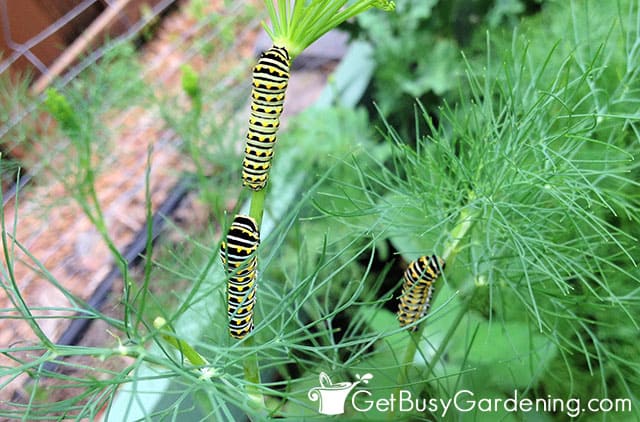
Disease Control
There aren’t many diseases that affect dill, but the few that can are powdery mildew and rot.
An organic fungicide may help slow down mildew. But your best defense against these types of infections are good watering practices and providing adequate air flow.
Don’t overcrowd them, and water near the base, rather than over top. This prevents soil from splashing up onto the leaves, and excess moisture from sitting on the delicate fronds.
Tips For Harvesting Dill
Dill is a two-for-one type of crop. Both the leafy fronds and the seeds are great to use in cooking and other applications.
You can begin harvesting the leaves as soon as the plant is 6” tall, but avoid taking more than a third of the total size at a time. Just snip the amount you’d like with a clean pair of pruners.
Once it flowers, you can harvest and save the seeds from the dried heads to both fill your spice rack, and keep them to replant next year.
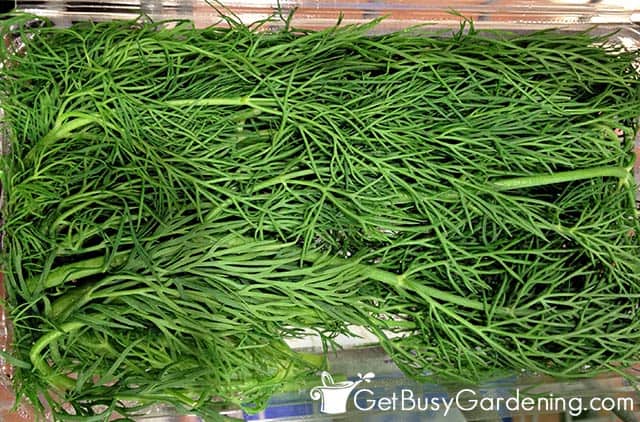
Dill Propagation Tips
Since it’s so short lived, the most common way to propagate dill is by seed. But they can also be rooted from stem cuttings in either water or soil.
You’ll want to tackle it in the early spring to give them plenty of time to grow before the summer heat.
Troubleshooting Common Problems
Dill is easier to grow than many beginners think, but you may still encounter one of these more common care issues throughout the season. Use my tips to help get back on track.
Dill Turning Yellow
Yellowing dill leaves can be caused by lack of light, over-fertilization, or overwatering. It tolerates some shade, but prefers full sun. Make sure it’s getting at least few hours of direct light every day.
Avoid fertilizing with full strength options more frequently than once a month, and do not use synthetic or chemical brands. Also, don’t water to the point of making the soil soggy or puddled.
Leaves Turning Brown
Lack of sun can also cause browning dill leaves, as can extended periods of dryness.
Make sure it’s receiving some sunlight every day, and avoid letting the soil go completely dry. Give it a deep drink whenever the top few inches are dry.
Dill Not Growing
If your dill is having trouble getting established or it’s not growing, that usually means the environment is not ideal.
Make sure there is sunlight, moist fertile soil, and moderate temperatures to encourage the best growth.
However, at the end of its short life, it will stop leafing in order to send up flower stalks. This is normal, and nothing to worry about.
Plant Is Bolting / Going To Seed
Bolting dill is a natural and expected part of the annual life cycle. It happens when temperatures sore to 80°F or higher.
If you favor the fresh fronds over the seeds, then you may be able to prolong its life by pinching off the flowers as they form, or removing the bloom stalk.
However, you can’t stop it from happening all together. So either pull the plant, or just let it naturally go to seed.
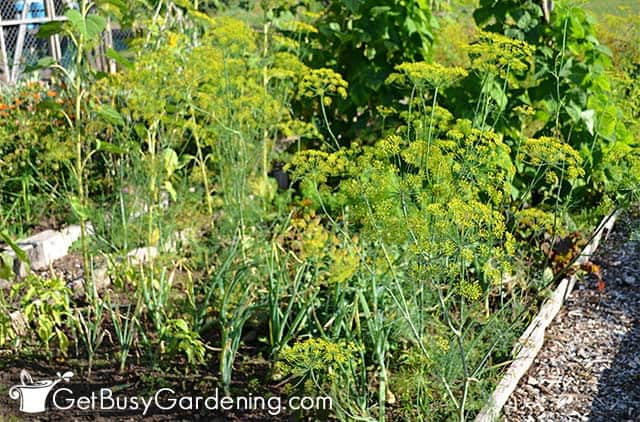
FAQs About Growing Dill
Here I’ve answered some of the most commonly asked questions about dill plant care. If yours isn’t on the list, please add it to the comments section below.
How long does dill take to grow?
Dill averages about 70-90 days from seed to full maturity, and then will continue to grow until it has finished flowering in the summer.
Is dill easy to grow?
Dill is easy to grow once you understand how to care for it. Provide sun, consistent water, fertile, well-draining soil, and occasional fertilizer for the best crop possible.
Why is dill so difficult to grow?
Dill isn’t difficult to grow once you understand the time of year it prefers. It thrives in the cooler temperatures of winter or early spring, and will flourish best when established before the summer heat kicks in.
Is dill weed the same as dill?
The term dill used alone refers to the entire plant. While the modifiers ‘dill weed’ and ‘dill seed’ are ways of classifying the difference between the leafy fronds and the seeds, respectively, in culinary uses.
Does dill come back every year?
Dill does not come back from the same plant every year, it is a short-lived annual. However, it does tend to self-sow as the flowers dry and drop seeds, so new plants may sprout the following spring.
Does dill need full sun?
Dill loves full sun, but can grow well in partial shade too, especially if it’s provided as protection from the hottest hours of the afternoon.
Now that you know exactly what kind of care dill needs to grow, it can become a regular in your spring garden every year. Even a beginner can have success with these tips at hand to guide them.
If you’d like to learn how to make the most of your space and get as much homegrown food as possible, then my Vertical Vegetables book is perfect! It will teach you all you need to know, has tons of gorgeous inspirational photos, and 23 DIY projects you can build for your own garden. Order your copy today!
Learn more about my Vertical Vegetables book here.
More About Herb Gardening
- How To Grow Tarragon At Home
- How To Grow Cilantro (Coriander) Plants
- How To Grow Thyme At Home
- How To Grow Oregano Plant At Home
- 13 Best Herbs To Grow Inside
Share your tips for growing dill in the comments section below.


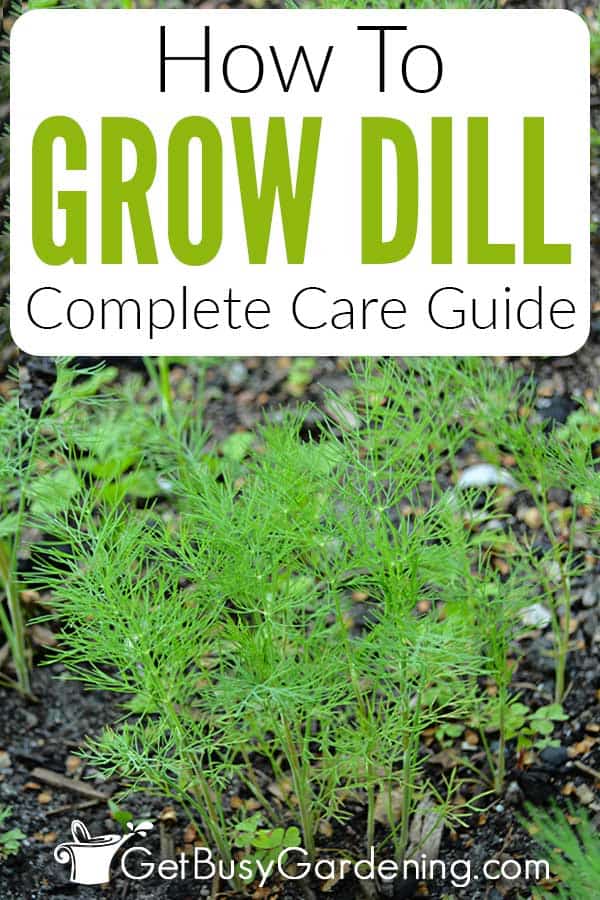



Leave a Reply